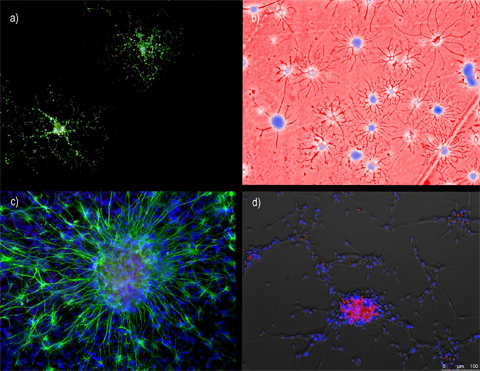Objectives:
The objective of the work package is to improve S&T experience and knowledge of researchers in molecular neuroscience and stem cell transplantation techniques for the treatment of neurodegenerative diseases by long term trainings at the Lund Stem Cell Center (Director - Prof. Henrik Semb), Lund, Sweden and exchange of know-how and experience with the scientific experts.
Background:
The Work Group Movement Disorders of the University Hospital Greifswald focuses on the pathogenesis and therapy of movement disorders with special interest in Parkinsons disease (PD). PD is the second most common neurodegenerative disorder after Alzheimers Disease (AD). PD has a prevalence of about 3% in elderly over 65 years. PD leads to a progressive deterioration of the patients` motor-function. Main symptoms are rigidity and tremor of the extremities, generalized hypokinesia. The disease is characterized by a selective degeneration of dopaminergic neurons in a part of the midbrain, the substantia nigra (SNR). This selective degeneration of one well defined cell group provides on one hand a good base for symptomatic treatment and on the other hand exhibits a good model disease for cell replacement strategies. Proof of principle studies showed the technical possibility of stereotactic transplantation of mesencephalic neural stem cells with dopaminergic differentiation potential. Unfortunately so far only a minority of the transplanted cells differentiate into dopaminergic neurons and integration into existing regulatory circuits of the CNS is poor. Therefore the optimization of dopaminergic differentiation of neural stem cells is an important yet so far unsolved goal. It is known, that the dopaminergic differentiation of mesencephalic neural stem cells goes primarily via the MAP-Kinase pathway. Nevertheless upregulation of the MAP-Kinase pathway alone leads only to immature dopaminergic neurons. Other additional signal pathways have therefore to be involved in the maturation and functional terminal differentiation to dopaminergic neurons. According to one hypothesis the non-canonical WNT pathway plays this role in mesencephalic neural stem cells with dopaminergic differentiation potential. On of the current mayor goals of our group is the dissection of the influence of the MAP-Kinase and WNT pathways in dopaminergic differentiation with the goal to selectively influence these pathways to improve the dopaminergic differentiation capacity of neural stem cells in comparison with currently used differentiation protocols. Our vision is that prospective results will improve the effect of stereotactic stem cell transplantation and will simultaneously reduce the side effects.

- Representative microphotographs showing mesencephalic neural stem cells during differentiation. a) GalC staining demonstrating oligodendroglial differentiation. b) Phase contrast images demonstrating astoglial and oligodendroglial differentiation. Living cells with blue soma. c) Typical "neurosphere" during neuronal differentiation (Map2 staining). Cell nuclei are counter-stained with DAPI. d) Bright-field images during neural differentiation; cells counter-stained with Hoechst (cell nuclei) and propidiumiodide (dead cells).
Task:
Close collaboration with the strategic partner will help to establish the technique of stereotactic stem cell transplantation to animal models of neurodegenerative diseases in the neuroscience research group of the EMA University of Greifswald. This will place us in a position to carry out functional in vivo studies in a Parkinson animal model (6-OHDA rat model) transferring the obtained in vitro data of the studies dealing with the improvement of the dopaminergic differentiation potential of mesencephalic neural stem cells to the living organism.
Description of the key personnel to be involved in the project:
Dr. Michael Sabolek [WP leader]
Expertise: neurodegeneration, cell culture, dopaminergic differentiation, signal transduction, gene expression
Prof. Dr. C. Kessler [Neurologist]
Expertise: clinical significance of molecular data
Ms Stefanie Huebner [PhD student]
Expertise: Cell culture, transplantation studies
Strategic partners:
Prof. Dr. Zaal Kokaia
Laboratory of Neural Stem Cell Biology, University of Lund (UL), Sweden
Recent publications related to the project:
- Sabolek M, Baumann B, Heinrich M, Meyer AK, Herborg A, Liebau S, Maisel M, Hermann A, Ventz K, Schwarz J, Wirth T, Storch A (2009) Initiation of Dopaminergic Differentiation of Nurr1(-) Mesencephalic Precursor Cells depends on Activation of Multiple Mitogen-Activated Protein Kinase Pathways. Stem Cells 27: 2009-2021.
- Buddensiek J, Dressel A, Kowalski M, Storch A, Sabolek M (2009) Adult cerebrospinal fluid inhibits neurogenesis but facilitates gliogenesis from fetal rat neural stem cells. J Neuroscience Res 87: 3054-3066.
Partners in Europe
Institutions in Greifswald
- University of Greifswald
Department of Neurology
Laboratory of Molecular Neurobiology
Ellernholzstraße 1/2
D-17489 Greifswald - University of Greifswald
Department of Neurology
Laboratory of Movement Disorders
Ferdinand-Sauerbruch-Straße
D-17489 Greifswald - University of Greifswald
Institute of Pathology
Department of Neuropathology
Friedrich-Loeffler-Str. 23e
D-17489 Greifswald - University of Greifswald
Institute of Pathophysiology
Greifswalder Straße 11c
D-17495 Karlsburg - BDH-Klinik Greifswald
Karl-Liebknecht-Ring 26a
D-17491 Greifswald




